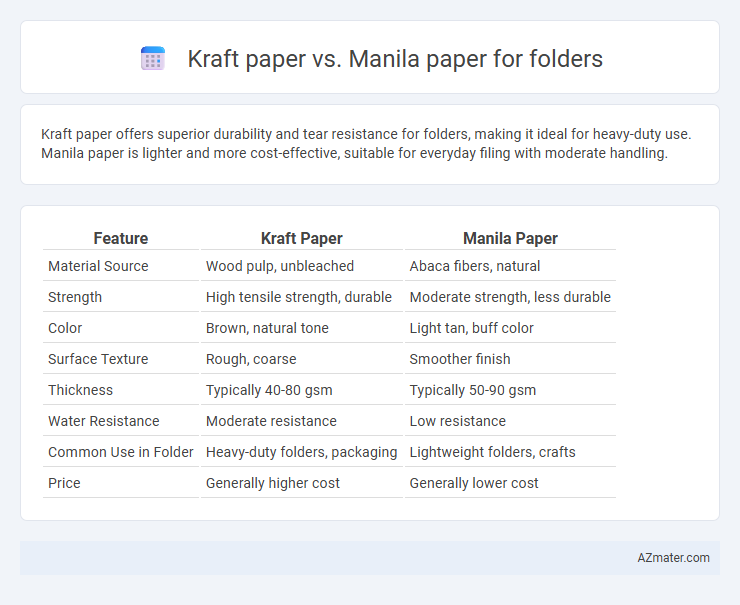Kraft paper offers superior durability and tear resistance for folders, making it ideal for heavy-duty use. Manila paper is lighter and more cost-effective, suitable for everyday filing with moderate handling.
Table of Comparison
| Feature | Kraft Paper | Manila Paper |
|---|---|---|
| Material Source | Wood pulp, unbleached | Abaca fibers, natural |
| Strength | High tensile strength, durable | Moderate strength, less durable |
| Color | Brown, natural tone | Light tan, buff color |
| Surface Texture | Rough, coarse | Smoother finish |
| Thickness | Typically 40-80 gsm | Typically 50-90 gsm |
| Water Resistance | Moderate resistance | Low resistance |
| Common Use in Folder | Heavy-duty folders, packaging | Lightweight folders, crafts |
| Price | Generally higher cost | Generally lower cost |
Introduction to Kraft Paper and Manila Paper
Kraft paper is a strong, durable material made from wood pulp using the kraft process, ideal for heavy-duty folders due to its tear resistance and natural brown color. Manila paper, derived from abaca fibers, offers a lighter, flexible option with a smooth texture and beige tone, commonly used for lightweight folders and document protection. Both papers are biodegradable and recyclable, but kraft paper provides superior strength while manila paper excels in ease of use and versatility.
Key Differences Between Kraft and Manila Paper
Kraft paper is made from chemical pulp with high tensile strength, providing durability and resistance to tearing, while manila paper originates from abaca fibers, offering a lighter and smoother texture suitable for folders and envelopes. Kraft paper typically has a natural brown color and is thicker, making it ideal for heavy-duty folder applications, whereas manila paper is usually lighter tan, thinner, and more flexible, emphasizing ease of writing and folding. The key difference lies in their fiber source and processing, impacting durability, texture, and common uses in folder manufacturing.
Composition and Manufacturing Processes
Kraft paper is made from wood pulp through the kraft process, which involves chemical treatment to remove lignin and strengthen fibers, resulting in durable, tear-resistant sheets ideal for folder production. Manila paper is derived from abaca fibers, a type of banana plant, processed via mechanical pulping that preserves fiber length but yields a softer, more flexible texture often used for lightweight folders. The chemical composition and manufacturing methods of kraft paper provide enhanced strength and moisture resistance compared to the natural, fibrous characteristics of manila paper.
Durability and Strength Comparison
Kraft paper offers superior durability and tensile strength compared to Manila paper, making it more resistant to tearing and wear in folder applications. The high lignin content and long fibers in Kraft paper enhance its ruggedness, ideal for heavy-duty use and frequent handling. Manila paper, while flexible and lightweight, lacks the robust structural integrity needed for long-term durability in folders subjected to stress.
Environmental Impact and Sustainability
Kraft paper is widely recognized for its eco-friendly properties due to its production from unbleached, virgin wood fibers, which makes it biodegradable and recyclable, reducing landfill waste. Manila paper, often made from abaca fibers, is also biodegradable but requires more chemical processing, which can increase its environmental footprint. For sustainable folder manufacturing, kraft paper offers superior environmental benefits through lower energy consumption and fewer harmful byproducts during production.
Cost Considerations: Kraft vs Manila
Kraft paper generally offers a lower cost compared to Manila paper, making it a budget-friendly option for folder production without compromising durability. The production process of Kraft paper involves unbleached wood pulp, reducing manufacturing expenses, while Manila paper requires more processing, resulting in higher costs. For businesses prioritizing cost-efficiency in bulk folder orders, Kraft paper presents a more economical choice with sustainable qualities.
Best Uses for Kraft Paper Folders
Kraft paper folders are best used for heavy-duty storage and transport due to their durability, tear resistance, and eco-friendly recycled content. They excel in industrial and office environments for organizing documents, files, and archival materials requiring strong protection. Manila paper folders, while lighter and more affordable, are better suited for short-term use and less demanding applications where aesthetic presentation is less critical.
Best Uses for Manila Paper Folders
Manila paper folders are ideal for organizing documents in offices, schools, and homes, providing durability and a smooth surface for writing or labeling. Unlike Kraft paper, Manila paper is less fibrous and has a clean, light beige color that enhances the folder's professional appearance. Best uses include filing important papers and projects where visibility and ease of customization are key.
Aesthetic Appeal and Customization Options
Kraft paper offers a natural, rustic aesthetic with its brown hues and rough texture, ideal for eco-conscious and vintage-themed folders, while manila paper provides a smooth, lighter beige surface that presents a more classic, professional look. Customization options for kraft paper include embossing, natural dyeing, and minimalistic printing, enhancing its organic appeal, whereas manila paper supports vibrant, detailed printing and easy lamination, allowing for diverse branding and color applications. Both materials offer durability, but kraft paper's texture adds a tactile dimension to folders, while manila paper's smooth finish ensures crisp, clear graphics and text.
Which Paper is Best for Folders? Final Verdict
Kraft paper is best for folders due to its superior strength, durability, and resistance to tearing, making it ideal for heavy-duty use and long-term storage. Manila paper, though lighter and more economical, lacks the robustness needed for frequent handling or heavier documents. For a reliable, long-lasting folder, kraft paper offers the optimal balance of toughness and quality.

Infographic: Kraft paper vs Manila paper for Folder
 azmater.com
azmater.com